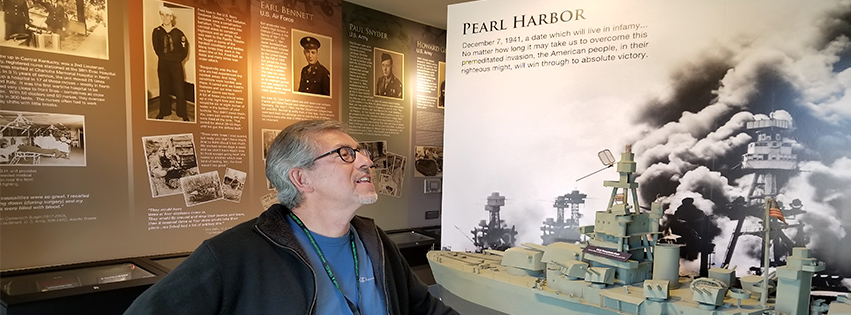
From Ashbourne Farms to Hermitage Farm. From veteran exhibits such as Pearl Harbor to the Road Warrior outdoor sculpture being dedicated in May 2021. The Oldham County Historical Society has compiled an extensive collection of exhibits that are sure to pique your interest. Some exhibits are temporary showings and some are extensive parts of the museum that have been designed to take your breath away!
Ashbourne Farms, La Grange
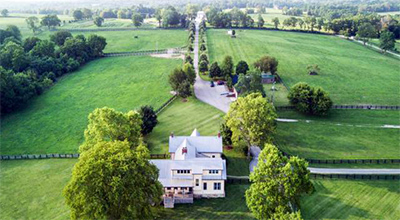 Ashbourne Farms is the agricultural legacy of W.L. Lyons Brown and Sally (Shallenberger) Brown. A wedding gift to the young couple in 1937–several Scottish Shorthorn cattle and a bull–given by Sally’s grandfather, Ashton Cokayne Shallenberger, the fifteenth governor of Nebraska, launched the makings of the property that stands today.
Ashbourne Farms is the agricultural legacy of W.L. Lyons Brown and Sally (Shallenberger) Brown. A wedding gift to the young couple in 1937–several Scottish Shorthorn cattle and a bull–given by Sally’s grandfather, Ashton Cokayne Shallenberger, the fifteenth governor of Nebraska, launched the makings of the property that stands today.
Ashton Cokayne Shallenberger owned a farm in Nebraska, called Ashbourne, where he bred shorthorns for a living. After his death in 1938, W.L. Lyons Brown and Sally named their budding property, Ashbourne Farms, in her grandfather’s honor.
From meager beginnings, the Browns built the farm from the ground up, suffusing the property with a deep love of agriculture and nature. This legacy is the foundation upon which the modern day iteration of Ashbourne Farms flourishes.
 Years of thoughtful care went into restoring the property to the picturesque splendor of its heyday; the entire farm, now listed on the national historic register. On it, stands a restored version of the original farmhouse, built in the late 1800’s, along with a number of other revived structures. More than that, Ashbourne Farms nurtures its vision of preservation and natural conservation with intention. In doing so, its family members opened Ashbourne Farms to the public, so that its beauty could be relished by others for generations to come. Ashbourne Farms has now become a much sought after organic CSA and Oldham Event Space
Years of thoughtful care went into restoring the property to the picturesque splendor of its heyday; the entire farm, now listed on the national historic register. On it, stands a restored version of the original farmhouse, built in the late 1800’s, along with a number of other revived structures. More than that, Ashbourne Farms nurtures its vision of preservation and natural conservation with intention. In doing so, its family members opened Ashbourne Farms to the public, so that its beauty could be relished by others for generations to come. Ashbourne Farms has now become a much sought after organic CSA and Oldham Event Space
Hermitage Farm, Goshen – an Oldham Farm Tour
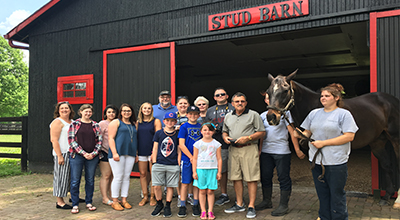
Hermitage Farm in Goshen, Ky., was originally a 3,000-acre Virginia Land Grant given to Gen. Hugh Mercer of Virginia. The Mercer family sold it to Capt. John Henshaw, whose son, Philip Henshaw, inherited the farm.
It was Philip Telfair Henshaw (1797-1835) who drew up plans for the house at Hermitage, which he modeled after his home in Virginia. During construction, he took his family with him to Virginia to visit his childhood home. Sadly, he became ill not long after arriving and died. His widow, Sarah Anne Scott Henshaw, returned to Hermitage to raise their three children and see to the completion of the house in 1836. She died in 1863, during the Civil War.
During the mid-1800s, more than 40 slaves lived and worked on the farm. One, known as Aunt Hannah, was the principle weaver, and slave George Page was central to many of the farm activities.
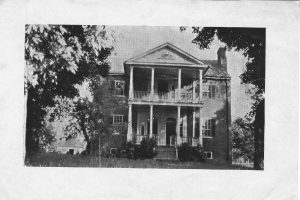 Sarah Anne and Philip’s daughter, Lucy Mary Jane (1831-1899), married Richard Waters (1825-1891). Lucy was his second wife and had been a neighbor. After marrying, they moved into Hermitage due to Lucy’s mother’s failing health. Richard raised cattle, sheep and hogs and grew orchard grass.
Sarah Anne and Philip’s daughter, Lucy Mary Jane (1831-1899), married Richard Waters (1825-1891). Lucy was his second wife and had been a neighbor. After marrying, they moved into Hermitage due to Lucy’s mother’s failing health. Richard raised cattle, sheep and hogs and grew orchard grass.
He also supervised the construction of U.S. Hwy. 42 around 1880-81. When it was finished in 1883-84, Richard bought Locust Grove and lived there until his death in 1891. Lucy and Richard Waters had five children. They gave Hermitage to their son, Phillip Edmund Waters, who married twice and had 13 children. Descendants of the Waters family continued to live at Hermitage until 1935.
The Oldham County Historical Society has in its possession the Henshaw-Waters collection, which once belonged to Elizabeth Waters. She was born at Hermitage in 1906.
Warner Jones Jr. and his wife, Harriet, purchased Hermitage in 1954. Under Jones’ direction, it became one of the most notable thoroughbred farms in the nation. During his career, he raised 156 winners. Jones must have had horse racing in his blood because one of his great-grandmothers was a Churchill.
Churchill Downs in Louisville was named for John and Henry Churchill, who leased 80 acres of land to their nephew, Col. M. Lewis Clark. Clark was Jones’ great uncle and was president of Churchill Downs when it opened in 1875. Clark was also the grandson of famed explorer William Clark. Jones’ father’s family started Frankfort Distillery, maker of Four Roses whiskey. Jones’ wife was a descendant of one of Louisville’s foremost families, the Seelbachs, of Seelbach Hotel fame.
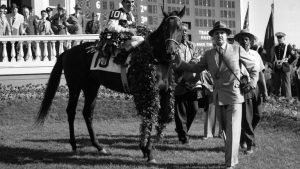 Warner Jones Jr. is the only person to breed winners of the Kentucky Derby (Dark Star, 1953), Kentucky Oaks (Nancy Jr., 1967) and a Breeders’ Cup Juvenile race (Is It True, 1988). In July 1985, Jones broke the Keeneland yearling sales with a record sale of $13.1 million for Seattle Dancer, a colt sold for himself and fellow breeders William S. Farish and William Kilroy. Jones served as chairman of Churchill Downs for eight years before stepping down in 1992 due to illness. He had overseen a revitalization of the track during his time there and was first elected to the board in 1941 when he was only 25 years old.
Warner Jones Jr. is the only person to breed winners of the Kentucky Derby (Dark Star, 1953), Kentucky Oaks (Nancy Jr., 1967) and a Breeders’ Cup Juvenile race (Is It True, 1988). In July 1985, Jones broke the Keeneland yearling sales with a record sale of $13.1 million for Seattle Dancer, a colt sold for himself and fellow breeders William S. Farish and William Kilroy. Jones served as chairman of Churchill Downs for eight years before stepping down in 1992 due to illness. He had overseen a revitalization of the track during his time there and was first elected to the board in 1941 when he was only 25 years old.
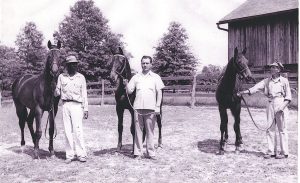 Jones died in 1994 at age 78. Hermitage Farm was sold to his close friend, Carl Pollard. Queen Elizabeth II had visited the farm in 1986, attesting to the farm’s nationally recognized name.
Jones died in 1994 at age 78. Hermitage Farm was sold to his close friend, Carl Pollard. Queen Elizabeth II had visited the farm in 1986, attesting to the farm’s nationally recognized name.
Jones’ widow, Harriet, was no stranger to the horse industry. She bred and sold (through Three Chimneys Farm) a Mr. Prospector colt for $3.7 million at the 2000 Keeneland July sale. This was the third-highest price at the sale. Pollard, Jones’ friend and golfing buddy, continued the successful thoroughbred tradition at Hermitage Farm. Very involved in the industry, he was the board chairman of Churchill Downs at one time.
Pollard had retired from Columbia Health Care Inc. and had been an officer for the Humana Corp. Inc. He owned the 2000 Breeders’ Cup Juvenile Fillies Winner and the Juvenile Champion Filly, Caressing.
 Steve Wilson and Laura Lee Brown purchased Hermitage in 2010 and currently own it. They had previously purchased 180 acres of unimproved acreage at Hermitage in 1993 before assuming ownership of the remainder of the 700-acre farm. The couple operates the eclectic 21C Museum Hotels and Kentucky Bison Co., the latter located in Goshen. They have launched a project to convert the famed thoroughbred horse farm into a tourist attraction to feature Kentucky-based foods, bourbon and horses. Learn more about the NEW Hermitage here.
Steve Wilson and Laura Lee Brown purchased Hermitage in 2010 and currently own it. They had previously purchased 180 acres of unimproved acreage at Hermitage in 1993 before assuming ownership of the remainder of the 700-acre farm. The couple operates the eclectic 21C Museum Hotels and Kentucky Bison Co., the latter located in Goshen. They have launched a project to convert the famed thoroughbred horse farm into a tourist attraction to feature Kentucky-based foods, bourbon and horses. Learn more about the NEW Hermitage here.
Whiskey Jug Exhibit
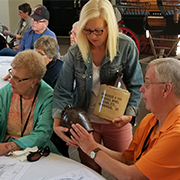 There is no doubt that James Chilton Barnett was a huge history buff. He was a faithful supporter for many years of the Oldham County Historical Society, being the organization’s president for 17 years and instrumental in establishing the Peyton Samuel Head Museum. In fact, he celebrated his 82nd birthday by attending the opening of the museum.
There is no doubt that James Chilton Barnett was a huge history buff. He was a faithful supporter for many years of the Oldham County Historical Society, being the organization’s president for 17 years and instrumental in establishing the Peyton Samuel Head Museum. In fact, he celebrated his 82nd birthday by attending the opening of the museum.
Originally from Pewee Valley, J.C. Barnett was the son of Alexander Chilton Barnett and Bessie Louise Hewett). His father was a prominent farmer and banker who first came to Oldham County in 1897 with his parents, John T. and Ivy Guthrie Barnett. Alexander married Bessie in 1904. Her parents were James Henry Hewett and Louise Cole. Bessie, whose family was in Oldham County as early as 1802, died in a train accident in 1925. J.C.’s siblings were Louise Barnett Summers and John Hewett Barnett.
In his lifetime, Barnett became a major financial contributor to the museum and one of its founding leaders. His first taste of history came from an encounter with a family Bible that listed marriages and births dating back to his maternal great-great-great-grandmother and grandfather. This spurred a deep love of history and a mission to make people aware of the importance of the county’s history.
For 25 years, Barnett ran Barnett’s Antiques in Pewee Valley. He was a longtime employee of the Louisville & Nashville Railroad Co. In his lifetime he was a member of the Pewee Valley Masonic Lodge 829, the Kentucky Historical Society, the Filson Club, and the Moose Lodge.
– A Passion for Stoneware –
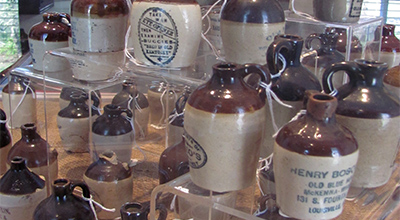 Barnett had a strong passion for stoneware jugs, which he collected for over 30 years. He collected only jugs that bore the names of Kentucky businesses. Most of the jugs were branded with the names of either the many small distilleries that flourished in the state for a century, from the early 1800s through the early 1900s, or the names of businesses such as drugstores or groceries. Most of the jugs were made of clay and baked in a kiln, but some were made at pottery companies in Louisville. If purchased from the pottery companies, such jugs may only have cost about a nickel to 10 cents apiece.
Barnett had a strong passion for stoneware jugs, which he collected for over 30 years. He collected only jugs that bore the names of Kentucky businesses. Most of the jugs were branded with the names of either the many small distilleries that flourished in the state for a century, from the early 1800s through the early 1900s, or the names of businesses such as drugstores or groceries. Most of the jugs were made of clay and baked in a kiln, but some were made at pottery companies in Louisville. If purchased from the pottery companies, such jugs may only have cost about a nickel to 10 cents apiece.
Barnett paid anywhere from 50 cents to $125 for the jugs. Most of the jugs in his collection contained whiskey, although other liquids were often sold in stone jugs such as mineral water, arsenic, vinegar, molasses and even mercury. The collectible jugs range in size from one ounce to five-gallon stone jugs. The most popular jugs had a one-gallon capacity.
